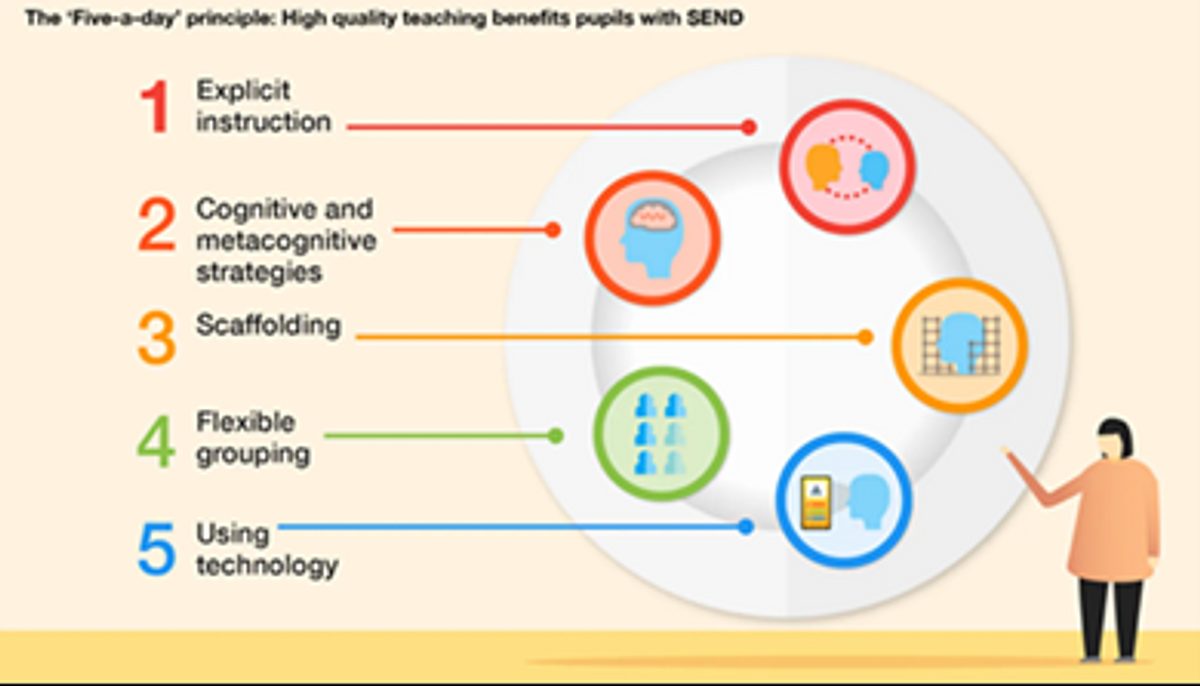What is adaptive teaching?
The Initial Teacher Training framework talks about responsiveness and ‘targeted support’, while Alex Quigley writes of the need for both ‘microadaptations’ and ‘significant adaptations’. Adaptive teaching is also described by Education Southwest as ‘being responsive to information about learning, then adjusting teaching to better match pupil need’, breaking it down into a 4‑step process:
1. Anticipate barriers
2. Plan to address them
3. Use assessment to elicit evidence of learning
4. Make in-the-moment adaptations
From a four-step process to the five-a-day approach
The EEF’s ‘Five-a-day approach’ describes the five approaches that the evidence base underpinning the SEN in Mainstream guidance report suggests teachers should be considering for all learners, including those with SEND:

Download the Five-a-day poster.
These don’t represent everything a teacher will ever need to do in relation to supporting pupils with SEND; they don’t replace the need for teachers to know their pupils and to develop secure relationships with their classes. They give reassurance, however, that the approaches many teachers use anyway are the ones that show signs of promise for pupils with SEND.
Taking the four-step process of adaptive teaching, how can we include elements of the EEF’s five a day approach so that our teaching incorporates the best available research evidence for pupils with SEND?
Anticipate barriers
For any teacher, planning well involves anticipating the learning experience for pupils. Typically, teachers anticipate which aspects of their lesson some (or all) pupils might find conceptually tricky, which content is particularly knowledge-rich or which tasks require pupils to acquire and apply a new skill. The best teachers do this with a strong understanding of the pupils they teach, including considering where barriers to learning may be relevant for pupils with SEND.
Plan to address them
Planning to address barriers to learning might involve a teacher planning a scaffold, such as a visual support, a written template or a verbal prompt, to support learners who are likely to find the learning tricky.
It might involve a teacher planning in the ‘cognitive strategies’ that are likely to support pupils’ learning. Though it will vary by phase and subject, this might mean organising information graphically to support pupils to understand a challenging concept, or using a mnemonic intervention such as an acronym or acrostic to help knowledge to ‘stick’.
Use assessment to elicit evidence of learning
Asking questions and checking for understanding are hallmarks of Rosenshine’s model of Explicit Instruction. A teacher working within this model moves pupils in stages towards independent practice, modelling carefully and using questioning to ensure pupils are ready for greater independence at each stage.
Increasingly, technology is also being used by teachers to gain a good assessment of pupils’ understanding, perhaps setting online quizzes and using this data to understand what next steps might look like.
Make in-the-moment adaptations
It may be that a teacher forms a ‘flexible group’ for a number of pupils who need additional support. With this temporary group, the teacher might reteach the content, clarify some vocabulary or address a misconception.
Alternatively, one in-the-moment adaptation might involve providing pupils with metacognitive strategies. The teacher might help the pupil who is stuck to consider whether a different strategy might help them, help the pupil who’s ‘lost’ to consider their understanding of the task they’re doing, or help the pupil who’s given up to consider how they can build and develop resilience within a task.
So what’s new?
Looking at the approaches listed above, you may think they are just a description of good teaching, rather than a revolutionary approach that will transform how educators lead their classes. And therein lies its most reassuring and greatest strength.
Put simply, ‘To a great extent, good teaching for pupils with SEND is good teaching for all’. That doesn’t make it easy – teaching consistently well is a target that eludes many of us – but it gives us a starting point for our pupils with SEND. And, whether we call it adaptive teaching or Five-a-day, the principles and approaches within both should give reassurance to teachers that meeting the needs of pupils with SEND doesn’t need to elude us.
Some further reading:
Special Educational Needs in Mainstream Schools | EEF (educationendowmentfoundation.org.uk)
EEF_SEND_Evidence_Review.pdf (d2tic4wvo1iusb.cloudfront.net)
EEF blog: Moving from ‘differentiation’ to ‘adaptive teaching’ | EEF (educationendowmentfoundation.org.uk)
Adaptive teaching: how teachers can use microadaptations | Tes
